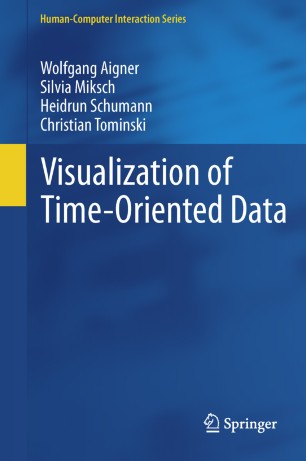Visualization of Time-Oriented Data

This book starts with an introduction to visualization and a number of historical examples of visual representations. At its core, the book presents and discusses a systematic view of the visualization of time-oriented data. This view is structured along three key questions. While the aspects of time and associated data describe what is being visualized, user tasks are related to the question why something is visualized. These characteristics and tasks determine how the visualization is to be designed. To support visual exploration, interaction techniques and analytical methods are required as well, which are discussed in separate chapters. The concepts explained in this book are illustrated with numerous examples.
A large part of this book is devoted to a structured survey of existing techniques for visualizing time and time-oriented data. Overall, 101 different visualization techniques are presented on a per-page basis; each of these self-contained descriptions is accompanied by an illustration and corresponding references. This survey serves as a reference for scientists conducting related research as well as for practitioners seeking information on how their time-oriented data can best be visualized in order to gain valuable insights.
zum Buch im ULB-Katalog
zum Buch auf der Verlags-Website
Corpus-based approaches to register variation
 As the first collective volume to focus exclusively on corpus-based approaches to register variation, this book provides an exhaustive account of the range and depth of possibilities that the domain of register variation in English has to offer. It illustrates register variation analysis in different theoretical frameworks, such as Probabilistic Grammar, Systemic Functional Linguistics, and Information Theory, and proposes a new framework within the Text Linguistic Approach: the continuous-situational analytical framework. Several of the contributions apply Multi-Dimensional Analysis to corpus data in order to unveil register (dis)similarities, while others rely on logistic regression models and periodization techniques based on Kullback-Leibler divergence. The volume includes both inter-register and intra-register variation analysis of a wide spectrum of varieties, speakers and periods: British and American English, learner varieties, L2 varieties, and also contains diachronic studies covering early and late Modern English. This broad scope should be a source of inspiration for anyone interested in historical and ongoing register variation in a vast range of varieties of English worldwide.
As the first collective volume to focus exclusively on corpus-based approaches to register variation, this book provides an exhaustive account of the range and depth of possibilities that the domain of register variation in English has to offer. It illustrates register variation analysis in different theoretical frameworks, such as Probabilistic Grammar, Systemic Functional Linguistics, and Information Theory, and proposes a new framework within the Text Linguistic Approach: the continuous-situational analytical framework. Several of the contributions apply Multi-Dimensional Analysis to corpus data in order to unveil register (dis)similarities, while others rely on logistic regression models and periodization techniques based on Kullback-Leibler divergence. The volume includes both inter-register and intra-register variation analysis of a wide spectrum of varieties, speakers and periods: British and American English, learner varieties, L2 varieties, and also contains diachronic studies covering early and late Modern English. This broad scope should be a source of inspiration for anyone interested in historical and ongoing register variation in a vast range of varieties of English worldwide.
zum Buch im ULB-Katalog
zum Buch auf der Verlags-Website
Weitere Titel zu den Digital Humanities finden Sie z.B. über eine Suche in disco.
